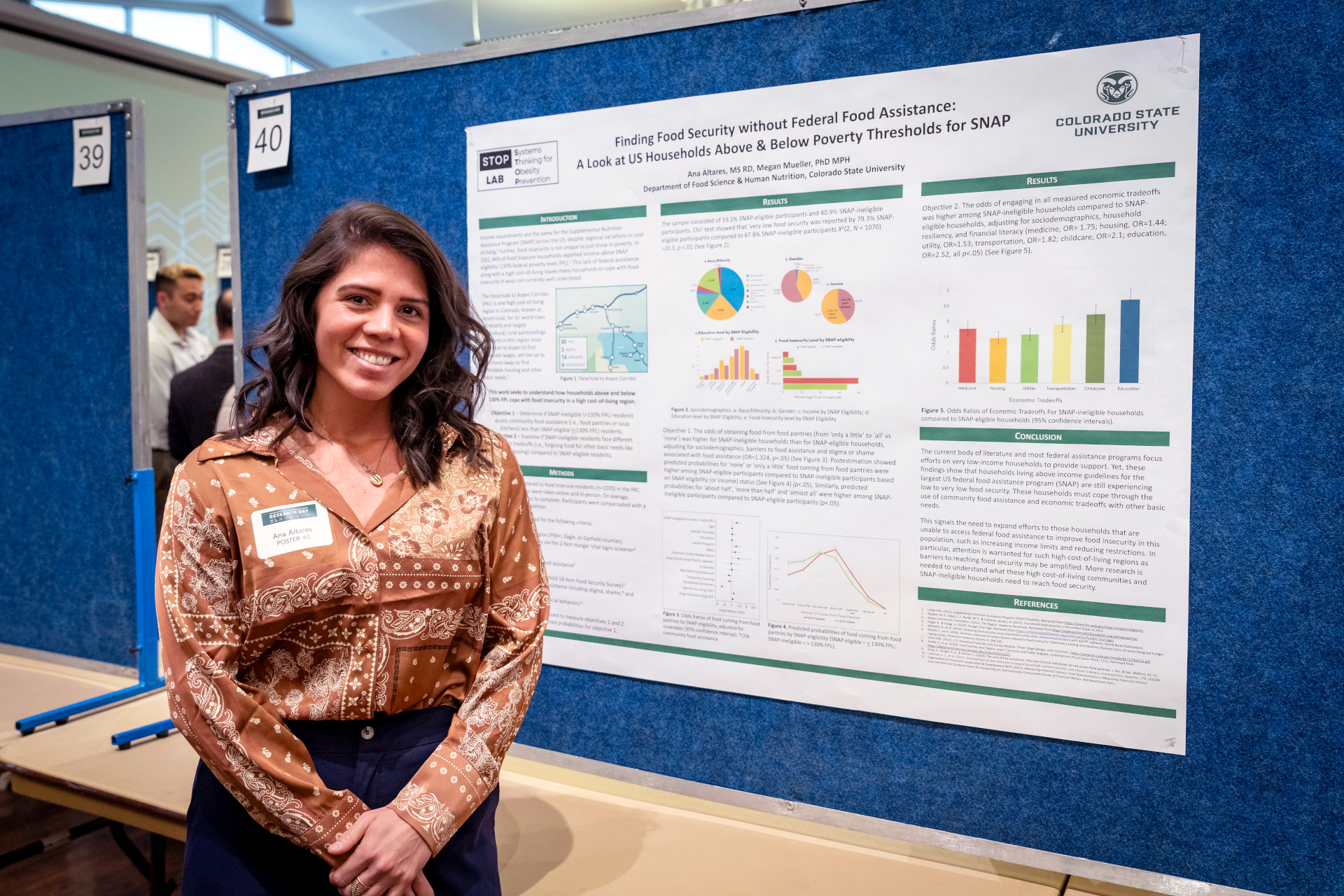
Two-thirds of workers in Colorado’s Aspen-to-Parachute corridor who earn more than allowed for federal food assistance still experience food insecurity and have higher odds of having to choose which bills to pay, according to a survey conducted by a Colorado State University doctoral student.
Ph.D. candidate Ana Altares is a third-year student working with faculty member Megan Mueller in CSU’s Department of Food Science and Human Nutrition. Altares surveyed 1,076 people who live or work in the “resort-rural” region of Pitkin, Eagle and Garfield counties, an area that recently had one home sell for $108 million.
Altares’ sample included 58.8% who qualified for Supplemental Nutrition Assistance Program (SNAP) aid (with eligible incomes at or below 130% of the federal poverty level) and 41.2% who did not qualify.
Altares found that 79.3% of SNAP-eligible survey participants reported “very low” food security, but so did 68.2% of SNAP-ineligible people surveyed. Altares said that, nationally, 44% of food-insecure households are not eligible for SNAP benefits because their net income is too high.

SNAP-ineligible participants sought food pantries
Altares said she will report the findings to community partners who requested the data. She also found that a higher-than-average number of SNAP-ineligible participants were likely to access food pantries and soup kitchens for most or all their food in the studied areas.
“I’m trying to reach these harder-to-reach populations, whether it be older residents or immigrants, people that are not usually heard from in research,” she said. “Policy implications may include increasing food access and dismantling the idea that food insecurity is just among people that are very impoverished or very hungry. Food insecurity also impacts folks that are not able to eat the kinds of foods they want to eat to be healthy.”
Many participants in the Aspen area drive two hours to work each way for jobs that pay enough for them to afford to live in the vicinity. Aspen itself in early 2024 had a median listing home price of $2.2 million and a median sold home price of $4.7 million, according to realtor.com.
Federal poverty level the same across mainland U.S.
According to the U.S. Department of Health and Human Services, the federal poverty level (a formula per number of people in a family) is the same for the lower 48 states. For a single person, that is annual income of $15,060; a person must earn 130% of this amount, or $19,578, to qualify for SNAP aid. For a family of four, the poverty level is $31,200, making the SNAP aid level $40,560.
Altares said the federal poverty level changes each year based on inflation. “But it’s the same for all 48 contiguous states and D.C. There’s no regional variation. So, it doesn’t matter if you live in Aspen, Manhattan or San Francisco, or if you live in Kalamazoo, Michigan,” she said. “That’s crazy to think that we should assume the same cost of living as we should for even eastern Colorado.”
The Aspen Community Foundation reported that a family of four’s self-sufficiency standard – not needing government or community support for basic needs – is $75,239 for residents of Garfield County, $76,608 for residents of Eagle County and $95,667 for residents of Pitkin County.
Altares found that a higher-than-average number of SNAP-ineligible participants were likely to engage in economic tradeoffs such as having to choose between things like food, medicine, housing and bills for things like utilities and transportation.

"Our future research funded by the USDA is looking into whether households that live above the federal poverty level for food assistance cope with food insecurity by making tradeoffs that influence their dietary quality as well."
Megan Mueller
‘It’s about having the right foods’
Altares explained the difficult choices made by people ineligible for SNAP as “treat or eat” decisions. “I’m either going to go hungry or I’m not going to get my diabetes medication. You must pick one,” Altares said. “That safety net is not there for those folks who have a little bit higher income.”
Altares said the way food insecurity is defined and measured should change, especially factoring in chronic conditions and food quality.
Altares’ research was supported by Mueller’s grant from the Colorado Agricultural Experiment Station Grants, a program through CSU’s College of Health and Human Sciences in collaboration with the USDA’s National Institute of Nutrition and Agriculture. Mueller collaborated on the grant with Rebecca Cleary from the Department of Agricultural and Resource Economics in the College of Agricultural Sciences.
“Our future research funded by the USDA is looking into whether households that live above the federal poverty level for food assistance cope with food insecurity by making tradeoffs that influence their dietary quality as well,” Mueller said.
The Department of Food Science and Human Nutrition is part of CSU’s College of Health and Human Sciences.